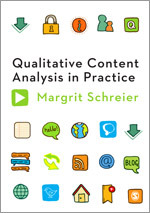Qualitative Content Analysis in Practice
- Margrit Schreier - Jacobs University Bremen, Germany
Qualitative Research (General)
In one of the first to focus on qualitative content analysis, Margrit Schreier takes students step-by step through:
- creating a coding frame
- segmenting the material
- trying out the coding frame
- evaluating the trial coding
- carrying out the main coding
- what comes after qualitative content analysis
- making use of software when conducting qualitative content analysis.
Each part of the process is described in detail and research examples are provided to illustrate each step. Frequently asked questions are answered, the most important points are summarized, and end of chapter questions provide an opportunity to revise these points. After reading the book, students are fully equiped to conduct their own qualitative content analysis.
Designed for upper level undergraduate, MA, PhD students and researchers across the social sciences, this is essential reading for all those who want to use qualitative content analysis.
This book provides a well written, clear and detailed account of QCA, highlighting the value of this research method for the analysis of social, political and psychological phenomena
Tereza Capelos
University of Surrey
Schreier writes clearly and with authority, positioning QCA in relation to other qualitative research methods and emphasising the hands-on aspects of the analysis process. She offers numerous illuminating examples and helpful pedagogical tools for the reader. This book will thus be most welcomed by students at different levels as well as by researchers.
Ulla Hällgren Graneheim
Umeå University, Sweden
This book has been written for students but would be of value to anyone considering using the analysis method to help them reduce and make sense of a large volume of textual data. [...]The content is detailed and presented in text-book style with key points, definitions and beginners’ mistakes scattered throughout and frequently asked questions and end of chapter questions. These break up the text but also help when skimming. In addition, and what I found particularly valuable, was the liberal use of examples drawn from published papers. These really help to clarify and bring to life the issues raised.
Schreier provides several helpful educational tools, such as mid-chapter definitions, summaries and key-points....this is an excellent introductory or reference book for all students of content analysis
This book makes a valuable supplementary reading text about applied content analysis for my course in ethnography.
I will use this as a recommended text, and not adopt as a main or compulsory text. This is so given the book's particular focus on QCA, and the more complex treatment of research issues in general, which will be of use to a limited number of students but will be a good resource potentially for some select few taking my spring 2014 senior thesis class and NOT the fall basic / intro research methods class. Thank you.











